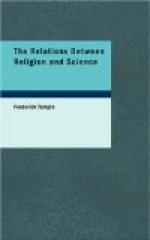When we pass to the New Testament, all that has previously been taught in the Old, in so far as it is related to the new teaching at all, is related as the bud to the flower. The development, if it be indeed a development, is so great, so sudden, so strange, that it seems difficult to recognise that it is a development at all.
First, the morality is in form, if not in substance, absolutely new. The duty of justice and mercy is pushed at once to its extreme limits, even to the length of entire self-surrender. The disciple has his own rights no doubt, as every other man has his; but he is required to leave his rights in God’s hands and to think of the rights of others only. The highest place is assigned to meekness in conduct and humility in spirit. The humility of the Sermon on the Mount may possibly by careful analysis be shown to be identical at bottom with the magnanimity of Aristotle’s Ethics. But the presentation of the two is so utterly opposed that in the effect on life the identity is altogether lost. And as justice and mercy, so too self-discipline is pushed as far as it can go. Instead of the enjoyment of life being an integral part of the aim set before the will, hunger and thirst for righteousness, and penitence for failure in keeping to it, are to fill up the believer’s hopes for himself. Of inward satisfaction and peace he is often assured; but these, and these only, are the means to that peace. The disciple’s life is to consist in bearing the cross, and bearing it cheerfully; in returning good for evil, and love for indifference and even for hatred; in detaching his affections from all the pleasures to be obtained from external things; in fixing his trust and his love on his Eternal Father. Taken as a whole, this is quite unlike all moral teaching that preceded it, and there is no indication that any philosophy could ever have evolved it. It has fastened on the human conscience from the day that it was uttered; and whatever moral teaching since has not been inspired from this source has soon passed out of power and been forgotten. We find when we examine that it exactly agrees with the fundamental teaching of the spiritual faculty when that teaching is applied to such creatures as we are, and to such a God as the New Testament sets before us. But we find it impossible to assert that by any working of human thought this morality could have been obtained by the spiritual faculty unaided. On the contrary, it seems more near the truth to say that we could




